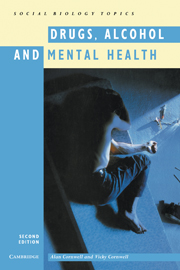Book contents
- Frontmatter
- Contents
- Preface
- 1 Drugs and drug abuse
- 2 Socially acceptable drugs
- 3 Misuse of prescribed and related drugs
- 4 Hallucinogenic drugs
- 5 Opiates and other narcotics
- 6 The biology of alcohol
- 7 The problems of alcohol use
- 8 Prevention and control of alcohol problems
- 9 Help for problem drinkers
- 10 Mental health and mental illness
- 11 Alzheimer's disease and other dementias
- 12 Other mental illnesses
- Further reading
- Index
11 - Alzheimer's disease and other dementias
Published online by Cambridge University Press: 05 June 2012
- Frontmatter
- Contents
- Preface
- 1 Drugs and drug abuse
- 2 Socially acceptable drugs
- 3 Misuse of prescribed and related drugs
- 4 Hallucinogenic drugs
- 5 Opiates and other narcotics
- 6 The biology of alcohol
- 7 The problems of alcohol use
- 8 Prevention and control of alcohol problems
- 9 Help for problem drinkers
- 10 Mental health and mental illness
- 11 Alzheimer's disease and other dementias
- 12 Other mental illnesses
- Further reading
- Index
Summary
Introduction
In the past dementia was a term used as a synonym for madness, but in modern usage it means a loss of or deterioration in intellectual abilities.
Dementia is an acquired brain disease which is both diffuse, affecting many parts of the brain, and chronic, that is long-term. The prevalence of all forms of dementia in the 65+ population is 5–7%. The age-related prevalence rises steeply to age 85–90, then levels off.
There are two main types of dementia in the elderly. These are Alzheimer's disease and multi-infarct dementia. In younger people, dementia is usually the result of an infection, traumatic event or the chronic misuse of alcohol or other drugs. Infections such as encephalitis or meningitis which cause damage to brain tissue may result in some degree of dementia. Dementia as a result of alcohol misuse may be acute or chronic, the signs and symptoms of each being very similar. The acute problem is Wernicke's encephalopathy and the chronic effect is Korsakoff's psychosis. In the former a confusional state and ataxia (uncoordination of voluntary muscle action, particularly in the muscle groups concerned with walking or reaching for objects) develop. The latter includes recent memory loss and often confabulation (inventing stories to fill memory gaps).
Alzheimer's disease
This condition was named after the psychiatrist who in 1907 first described this type of dementia occurring in middle-aged people (pre-senile dementia). Two types of Alzheimer's disease are recognised.
- Type
- Chapter
- Information
- Drugs, Alcohol and Mental Health , pp. 86 - 91Publisher: Cambridge University PressPrint publication year: 1993



